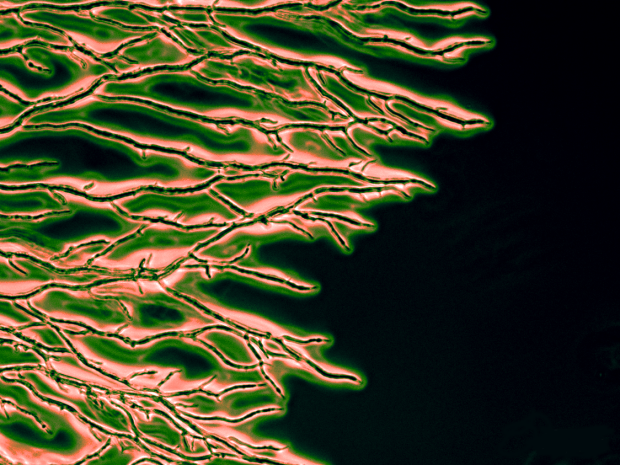Scientists have identified a “tipping point” in fungal evolution that dramatically impacts their growth and form. This discovery, published in Cell Reports, highlights how seemingly minor environmental shifts can trigger major evolutionary consequences.
 Hyphal mycelium. Image Credit: Maxim Ohairwe
Hyphal mycelium. Image Credit: Maxim Ohairwe
Fungi serve as nature's primary decomposers. Nestled within the forest floor, they patiently await fallen trees and autumn leaves, breaking them down and returning vital nutrients to the Earth.
While fungi are commonly associated with mushroom caps, they also possess underground "roots" known as mycelia. Comprising thousands of interconnected, microscopic, finger-like cells called hyphae, mycelia form extensive networks. Hyphae navigate through the soil by elongating from their tips, a process akin to inflating long balloons used for making balloon animals.
The elongated structure of hyphae enables them to search for and absorb nutrients from the soil. However, hyphae come in different shapes: some have rounded tips, while others are pointed. Water molds, which are fungus-like pathogens responsible for crop blight, notably possess pointed hyphae.
A major challenge in biology is to identify the specific evolutionary factors that determine the shape - or form - of a given organism.”
Enrique Rojas, Assistant Professor and Study Senior Author, Department of Biology, New York University
To comprehend the factors influencing the various shapes of hyphae, Rojas and his team merged theory with experiments to study fungi and water molds from diverse environments. Initially, they utilized physics-based models of tip growth to ascertain all conceivable shapes of hyphae. Surprisingly, the observed shapes of hyphae in nature represented only a limited subset of the potential shapes.
The researchers suspected that the limited shapes observed in nature were a result of “survival of the fittest.” They believed the many shapes not seen in real fungi were evolutionary dead ends – unfit for survival. To test this theory, they created a fitness landscape by comparing the growth rates of hyphae with different shapes.
Our eureka moment was when we realized that the shapes of hyphae were intimately connected to their ability to grow fast.”
Maxim Ohairwe, Ph.D. Student and Study Lead Author, Department of Biology, New York University
A fitness landscape resembles a topographic map illustrating the evolutionary journey of an organism. Each species navigates through its fitness landscape by assessing whether random mutations in its genes enhance its growth rate or fitness. This exploration continues until a mutation decreases its fitness, signaling that it has reached a fitness peak and concludes its continuous exploration.
Rojas’s team discovered that fitness landscapes can exhibit complexity beyond simple peaks and valleys. Specifically, they identified an overhanging cliff, or tipping point, within the fitness landscape for hyphae.
This cliff serves as a barrier to evolution, significantly constraining the shapes of fungal hyphae. Consequently, they predicted that hyphae with shapes near the brink of this tipping point would be especially susceptible to minor environmental, chemical, or genetic alterations.
The researchers validated their prediction by subjecting fungi near the tipping point to small doses of chemicals impacting hyphal growth. They employed one chemical to decrease pressure within the hyphae and another, derived from a sea sponge, to inhibit the hypha's transportation of cellular components to the cell tip.
Both treatments resulted in a notable outcome: the hyphae exhibited significantly slower elongation and an unusual nub-like shape not typically observed in nature.
Our findings explain hyphal shape diversity in an enormous, diverse, and important group of species. More broadly, they also demonstrate an important new evolutionary principle: that fitness landscapes can have instabilities, or tipping points, that impose strict constraints on complex traits, like biological form.”
Enrique Rojas, Assistant Professor and Study Senior Author, Department of Biology, New York University
The researchers assert that their findings have crucial implications for comprehending numerous ecological and evolutionary systems. For instance, species whose evolution is influenced by a tipping point may be highly susceptible to the gradual rise in temperature resulting from climate change.
Moreover, their discoveries could facilitate the development of novel antimicrobials targeting disease-causing fungi by pinpointing vulnerabilities in their growth linked to an evolutionary tipping point.
Hyphae of the fungus Allomyces arbuscula
Hyphae of the fungus Allomyces arbuscula growing as part of a mycelium. Video Credit: Maxim Ohairwe
Source:
Journal reference:
Ohairwe, E, M., et al., (2024) A fitness landscape instability governs the morphological diversity of tip-growing cells. Cell Reports. doi.org/10.1016/j.celrep.2024.113961